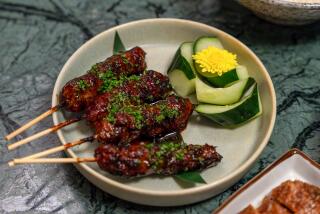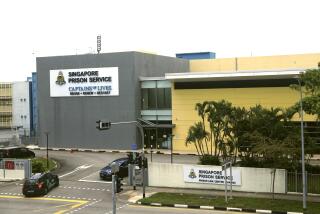Singapore’s Success Is Testament to Tough Management
- Share via
SINGAPORE — In a world of cities crushed by population and crumbling in poverty, the prosperous city-state of Singapore qualifies as an urban success story--by almost any measure.
Where slums once spread over the landscape, new high-rise apartments now house 80% of the population of 2.5 million. Superhighways thread through the tiny island, a new subway system is being built, the air is clean, crime infrequent and the garbage is picked up every day.
Today’s Singapore is a testament to tough-minded city management, and may be a model for a Third World burgeoning with unmanageable cities.
By the year 2000, United Nations specialists say, poorer nations will have 45 cities of more than 5 million population, most of them in Asia.
‘An Excellent Example’
The United Nations’ chief population official, Rafael M. Salas, says Singapore is “an excellent example” of how to control city growth and improve urban life through family planning and economic development.
“Those two coming together is what is hoped for in the rest of the world,” Salas said in a New York interview.
But he and others acknowledge that much of this east Asian city’s success rests on rigid social controls.
Some controls are minor: Public “break-dancing” is banned, litterbugs and jaywalkers are fined and young men with long hair sometimes have to wait for service in government offices.
But others controls are severe. Convicted drug traffickers are often hanged. Suspected subversives can be jailed for years without charge or trial. And the family-planning system imposes penalties on those who bear more children than the government wants.
How did Singapore get this way?
Self-Rule From Britain
The island colony and its largely Chinese population gained self-rule from Britain in 1959. It was ousted six years later from a federation with Malaysia. Singapore became a new, 239-square-mile nation, “the smallest of shrimps in a sea of hungry fish,” in the words of Lee Kuan Yew, who led Singapore to independence and still leads it today as prime minister.
The economic base was unpromising.
“Before 1960 Singapore had some of the worst slum conditions in Southeast Asia,” writes international urbanologist Aprodicio A. Laquian. The future seemed especially gloomy when Britain began winding down its sprawling military bases, long the island’s economic mainspring.
But Lee’s team, believing in freewheeling capitalism, turned the small shrimp into a well-fed king crab.
Former army camps now throb with industrial vitality. Trading in the “international dollar” enabled Singapore to rival Hong Kong as a financial center. The city is now moving aggressively into high technology. Singapore’s current standard of living -- per-capita annual income equivalent to $5,200 -- is second only to Japan’s in Asia.
The housing shortages and the other urban woes afflicting much of the Third World seem less burdensome--or under greater control--here.
Modern Apartments
The Housing Development Board has built vast projects of clean, modern apartment buildings, selling apartments at subsidized prices. To pay for them, buyers may withdraw their funds from the government’s compulsory social security system.
“Today, 80% of our population is housed in half a million . . . dwelling units. Of these, 75% own their own flats,” says the national development minister, Teh Cheang Wan.
For an island so densely populated, with little local water, no domestic energy resources and heavy industrialization, Singapore has surprisingly few problems of power supply, water reserves or pollution.
Most of its water is piped across a highway-railroad causeway from nearby Malaysia. When reservoir levels drop enough to cause official concern, the jingle “Don’t Be a Water Waster” is repeatedly aired on radio and television. Rationing has not been necessary.
Three steam power stations and two gas turbine generating plants provide a steady supply of electricity, freeing Singapore from the regular power cuts that darken other Third World cities.
And while such places as Mexico City, whose air is considered the world’s dirtiest, struggle to establish environmental controls, the Singapore Environment Ministry already has 14 permanent stations monitoring air pollution, which officials say is well within World Health Organization standards.
‘Rugged Society’
Singapore has traffic jams, but nothing like the near-gridlock that often strangles such cities as Bangkok, Thailand. Private cars must carry at least four people or display a $46-a-month sticker to enter the central business district during the morning rush hours.
In Lee’s “rugged society,” where obedience, cleanliness, thrift and the profit motive are supreme, controls are everywhere.
The government harasses the political opposition and guides the officially licensed press. As part of a government effort to attain “zero growth” in Singapore’s population, couples with more than two children are penalized in housing allocations and educational opportunities.
The single most important control, however, may be Singapore’s ability, being both a nation and a city, to keep outsiders from pouring in from impoverished nearby countrysides, something few Third World metropolises are able or willing to do.
150,000 Foreign Workers
Only about 150,000 foreigners work here, most from Malaysia and Indonesia, filling construction, shipyard and other physically demanding jobs spurned by increasingly affluent natives of Singapore. The government even has plans for these non-Singaporeans, hoping to “phase out” foreigners by 1991 as the economy shifts toward technological industries.
The Singapore system provokes some local dissent.
“The major issue here is centralization, the concentration of power . . . . We must get rid of our absurdly rigid structure,” Toh Chin Chye, a dissident in Lee’s People’s Action Party, said in a recent interview with Asiaweek magazine. But the firm hand that steers this city has broad support.
When they chose a new Parliament in elections Dec. 22, Singapore voters gave 77 of the 79 seats to the People’s Action Party.
More to Read
Sign up for Essential California
The most important California stories and recommendations in your inbox every morning.
You may occasionally receive promotional content from the Los Angeles Times.













